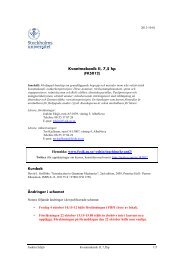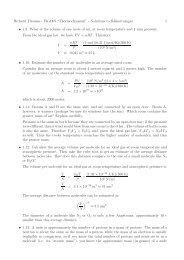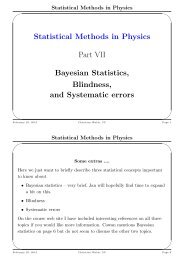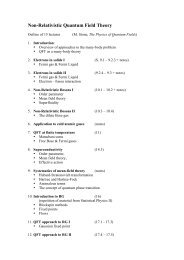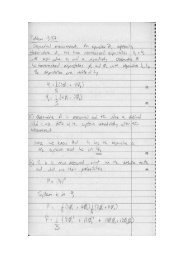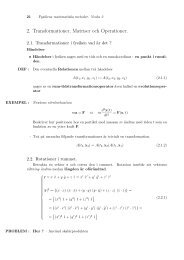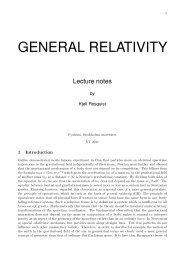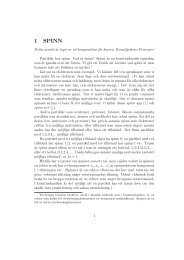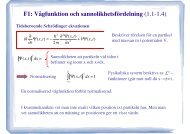Final Examination Paper for Electrodynamics-I [Solutions]
Final Examination Paper for Electrodynamics-I [Solutions]
Final Examination Paper for Electrodynamics-I [Solutions]
Create successful ePaper yourself
Turn your PDF publications into a flip-book with our unique Google optimized e-Paper software.
J is parallel to dl and the variation of B over the cross section can be neglected.<br />
Then, <br />
V d3x J(x) × B(x) = <br />
l S ( ds · dl)( J × B) = <br />
l S ( ds · J)( dl × B). This gives<br />
the <strong>for</strong>ce on wire l due to the magnetic field B as,<br />
F = I<br />
<br />
dl ×<br />
c<br />
B .<br />
l<br />
Now consider a rectangular current loop with its height L parallel to the z-axis,<br />
placed in a uni<strong>for</strong>m magnetic field B in the ˆy direction. Clearly the loop edges of<br />
length w are in the x − y plane. Let θ denote the angle between the vector normal to<br />
the loop area and the magnetic field B along ˆy. Clearly this also is the angle between<br />
the edge of length w and the x-axis. Now using the above <strong>for</strong>mula, the <strong>for</strong>ces on<br />
the two edges Lˆz and −Lˆz are ∓(I/c)LBˆx, respectively. The <strong>for</strong>ces on the top and<br />
bottom edges of length w become ±(I/c)wB cos θˆz. The total <strong>for</strong>ce adds up to zero.<br />
As <strong>for</strong> the torque, the <strong>for</strong>ces along ˆz act colinearly and produce no torque. The pair<br />
of <strong>for</strong>ces along ˆx are not colinear and produce a torque τ = w × F , where w denotes<br />
the vector length of top edge of the loop. Then,<br />
τ = wF sin θ ˆz = (I/c)wLB sin θ ˆz .<br />
b) Taking the divergence of both sides of the equation, the left hand side vanishes<br />
∇ · ( ∇ × B) = 0. But, on using the continuity equation, the right hand side is<br />
proportional to ∇ · J = −∂ρ/∂t which is non-zero in time dependent situations.<br />
Hence in these cases, the equation is not consistent with charge conservation. To<br />
restore consistency with charge conservation, we have to modify J on the right hand<br />
side to some J + · · · so that the new quantity always remains divergenceless. Such a<br />
quantity is obtained by combining the continuity equation with the Maxwell equation<br />
∇ · E = 4πρ which gives, ∇ · ( J + 1<br />
becomes ∇ × B − 1 ∂<br />
c<br />
E<br />
∂t<br />
= 4π<br />
c J.<br />
4π ∂ E/∂t) = 0. Hence, the modified equation<br />
4. Consider Maxwell’s equations in a medium of constant permittivity ɛ and permeability<br />
µ in the absence of sources.<br />
(a) Show that the equations admit plane-wave solutions. Determine the velocity<br />
of the plane wave and explain the index of refraction.<br />
(b) Show that E, B and the wave vector k are all perpendicular to each other.<br />
Solution (points: 13)<br />
a) To show that Maxwell’s equations in the absence of sources admit plane wave<br />
solutions, one first shows that they reduce to wave equations <strong>for</strong> E and B. For this,<br />
take curls of the two equations containing ∇ × E and ∇ × B and simplify using<br />
the vector identity ∇ × ( ∇ × E) = −∇2E + ∇( ∇ · E). Now use the remaining two<br />
Maxwell equations to get decoupled wave equations of E and B,<br />
<br />
∇ 2 − µɛ<br />
c2 ∂2 ∂t2 <br />
<br />
E = 0 , ∇ 2 − µɛ<br />
c2 ∂2 ∂t2 <br />
B = 0 .<br />
4


![Final Examination Paper for Electrodynamics-I [Solutions]](https://img.yumpu.com/21085948/4/500x640/final-examination-paper-for-electrodynamics-i-solutions.jpg)
